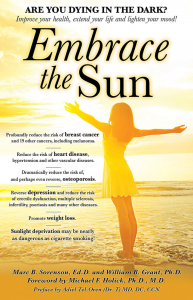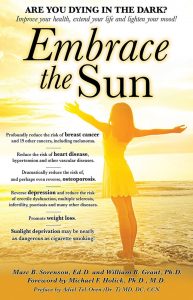 Blondes and Sunlight. By Marc Sorenson, EdD
Blondes and Sunlight. By Marc Sorenson, EdD
Blondes, according to recent research, have longer life spans, and sunlight “could be” the key.
The study involved 29,518 Caucasian women aged 25 to 64, and followed for 25 years, determined their risk of skin cancer and death. Therefore, the researchers formed two groups in the incipient stages of the investigation. Thus, one group was a “fair” group, or blondes, meaning they had red hair or freckles. Another group was the “non-fair” or non-blonde group and served as a control. Furthermore, the researchers matched each person in the fair group with someone in the non-fair group, during the 25-year period. This matching included similar age, smoking habits, education, marital status, and income. The main outcome desired was a comparison of all-cause death (mortality) and mortality from skin cancer in the two groups.
Who lived longer, blondes or non-blondes?The researchers showed that the blondes had significantly lower all-cause death. Still, they had a higher mortality from skin cancer.
Contrasted and compared to the non-blondes, the blondes had significantly reduced all-cause death. What could be the reason for the reduced mortality? One might surmise that sunlight probably played a part. Yet, sunlight was not a focus of this investigation.
Nevertheless, it is especially relevant that these researchers, in a 20-year study on sunlight, showed other surprising results. In a study on sunlight exposure, they demonstrated an amazing fact. They showed that low sun exposure habits were approximately as dangerous as smoking. This was probably due to reduction in cardiovascular disease (heart and vessel disease) among those who soaked up more sun.
Why might light-skinned people have an advantage?
Those who have lighter skins make vitamin D and other important sunlight photoproducts at a rapid rate. Some of those photoproducts are nitric oxide, serotonin, endorphin, dopamine, and BDNF. Furthermore, all of those photoproducts are essential to human health. So could this be the reason that blondes lived longer than non-blondes? For more information on the effects of these photoproducts, visit sunlightinstitute.org and read the book, Embrace the Sun.
A final, salient point regarding sunlight, blondes and skin cancer:
A most noteworthy thought: people who have light skins and/or freckles are already at dramatically increased skin-cancer risk. Thus, it is light skin, freckles and moles that increase skin cancer; it is not sunlight. If the blondes group had accumulated more sunlight exposure, It might have actually protected them from skin cancer. Read more about how sun prevents skin cancer in Embrace the Sun. Regular, non-burning sun exposure is vital.
Happy sunning!
Coronavirus, sunlight and vitamin D. More compelling information. Take action now. By Marc Sorenson, EdD.

 Coronavirus, (Covid-19), like most flu-like diseases, will probably disappear in much of the Northern hemisphere in the coming summer. Nevertheless, it will return on steroids in the fall and winter. Yet, it does not have to return to you or your family and friends. We can do something! However, why wait? Let us start now! Does anyone reading this really want to wait for the “second wave” and then go into panic mode? Of course not. In addition, do you want to let the vaccine Nazis also spend $billions more of our tax dollars looking for a vaccine? Of course not. The answer to stopping coronavirus is all around us. We need only to seek it and use it.
Coronavirus, (Covid-19), like most flu-like diseases, will probably disappear in much of the Northern hemisphere in the coming summer. Nevertheless, it will return on steroids in the fall and winter. Yet, it does not have to return to you or your family and friends. We can do something! However, why wait? Let us start now! Does anyone reading this really want to wait for the “second wave” and then go into panic mode? Of course not. In addition, do you want to let the vaccine Nazis also spend $billions more of our tax dollars looking for a vaccine? Of course not. The answer to stopping coronavirus is all around us. We need only to seek it and use it.
Two papers show remarkable associations of coronavirus with vitamin D.
If you are not convinced of the power of sunlight after reading this, I despair of being able to help you prevent this fall’s “second wave.”
The first paper was by a team of Indonesian researchers. One might think that Indonesians would have ample vitamin D levels due to an abundance of sunlight. Thus, this should protect them from vitamin D deficiency. However, most Indonesians avoid the sun and keep their skins as white as possible. It is a national quest in the Philippines to be as light-skinned as possible, so that they can consider themselves as “upper crust.” Hence, the population has a great deal of vitamin D deficiency.
The researchers focused on identifying patterns of mortality (death) between coronavirus deaths and vitamin D levels. They conducted the study with a sample of 780 subjects, all who had laboratory confirmed coronavirus infection.
Here are the findings on vitamin D levels and coronavirus mortality:
- Mortality rates were 13 times higher in patients who were vitamin D insufficient (21-29 ng/ml) compared to those who had normal levels (>30 ng/ml).
- Mortality rates were 19-times higher in patients who were vitamin D deficient (<20 ng/ml).
- Even when controlling the data for age, gender and preexisting conditions, the vitamin D deficient cases were more than 10 times more likely to die than those who had normal levels.
No wonder the Indonesians are now seeking the sun and appreciating it after years of avoiding it. See the picture below of Indonesian men social distancing while soaking up the rays.
An important point regarding vitamin D and coronavirus:
Vitamin D levels above 30 ng/ml are not necessarily “normal,” and it is likely that 50-60 ng/ml would be a better number. People who are constantly in the sunshine, i.e. lifeguards, often have levels above 70 ng/ml. Dr. Bruce Hollis and his colleagues suggested that lifeguards have the “true normal” levels. They believe that a population of “normal” volunteers with average levels of 27 ng/ml may exhibit vitamin D deficiency. Another similar study showed that “normal” adults had 25(OH)D levels of about 27.2 ng/ml, whereas lifeguards had levels of approximately 70 ng/ml].
Could the real pandemic be a pandemic of sunlight deficiency resulting in a pandemic of vitamin D deficiency?
If >30 ng/ml provides this much protection against coronavirus, levels > 60 ng/ml would probably provide complete protection. Everyone should have a vitamin D assessment, and then get out in the sun, during this time of the coronavirus epidemic. For your own health, and the health of those you love, schedule a test, and make your goal 60 ng/ml.
Paper # 2
Another paper by Mark Alipio, done in the Philippines, was similar to the Indonesian study. Thus, it showed that coronavirus patients with normal vitamin D levels had a mild disease outcome. The outcome for those patients was 19.6 times better than for those with low levels.
A fact everyone should remember:
Ninety percent of serum vitamin D levels are due to sun exposure, which causes the skin to produce vitamin D3. Therefore, vitamin D levels are surrogate measurements for sun exposure. You must not assume that vitamin D capsules will supply all the beneficial effects of sun exposure or sunbed exposure. Both sunlight and sunbed light produce photoproducts that have health effects far beyond vitamin D. Safely sunbathe (without burning) to achieve optimal vitamin D levels. Moreover, while so doing, you will produce other remarkably important health benefits.
For more information on the extraordinary health benefits of sun exposure, visit sunlightinstitute.org and read my book, Embrace the Sun.
Another important research paper on sun exposure and the risk of cancer was completed in March of 2016.[1] In it, the researchers showed once again that areas of greater sun exposure have lower rates of most cancers than areas of lesser sun exposure. To make their assessment, the investigators first obtained data from the North America Land Data Assimilation System daily average sunlight for the continental United States. They then compared that data to cancer incidence and mortality from the Centers for Disease Control.
They found that cancer incidence for all invasive cancers was significantly decreased with increasing solar radiation (sun exposure). Invasive cancer is cancer that has spread beyond the layer of tissue in which it developed and is growing into surrounding, healthy tissues.[2] The same was true for 11 of 22 leading cancers. Interestingly, however, there was no correlation with mortality with increasing solar radiation when the invasive cancers were considered, although mortality from 7 of 22 leading cancers, including cancers of the uterus, leukemias, lung, ovary and urinary bladder did significantly decrease with increasing solar radiation. Liver cancer increased both in incidence and mortality with increasing sun exposure, and cervical cancer increased in incidence but not mortality. However, the adverse effect on liver cancer may be balanced by the very positive effects of sun exposure in decreasing liver inflammation.[3]
All-in-all, this research is very positive in presenting the anti-cancer effects of sun exposure on most cancers. Be sure to obtain your share of safe, non-burning sun exposure.
[1] Fleischer A, Fleischer S, Solar radiation and the incidence and mortality of leading invasive cancers in the
United States Dermatoendocrinol. 2016 Mar 28;8(1):e1162366
[2] http://www.cancer.gov/publications/dictionaries/cancer-terms?CdrID=45741
[3] Gorman S, Black LJ, Feelisch M, Hart PH, Weller R. Can skin exposure to sun prevent liver inflammation? Nutrients 2015 May 5;7(5):3219-39.
By Marc Sorenson, EdD Sunlight Institute
Those of us that understand the importance on regular sun exposure on human health were not surprised by the most recent research by Dr. Pelle Lindqvist and colleagues. It showed that women who had active sun-exposure habits lived longer than those who did not.[1] Over a 20-year period, the study demonstrated that compared to the highest sun-exposure group, life expectancy of sun avoiders was reduced significantly. Much of the reduction in death among the sun-exposed group was due to a lessened risk of cardiovascular disease and non-cancer, non-cardiovascular death. The risk of skin cancer was slightly increased among the sun exposed group, primarily because they lived longer and had more time to contract cancer.
Perhaps the most impressive statement to come out of the research was this: “Nonsmokers who avoided sun exposure had a life expectancy similar to smokers in the highest sun exposure group, indicating that avoidance of sun exposure is a risk factor for death of a similar magnitude as smoking.”
This newest research is just one of several important contributions by Lindqvist and his group. Other assessments of the 20-year study revealed that the subjects who avoided sun exposure were twice as likely to die of any cause compared to those who had the highest sun exposure, and the researchers made this statement: “In both models the summary sun exposure variables showed a ‘dose-dependent’ inverse relation between sun exposure and all-cause death.”[2]
The research also showed that women with “normal” sun exposure habits were not at significantly increased risk of either melanoma or melanoma-related death. The publication seemed to give vitamin D most of the credit for increased life spans among those who had high sun exposures, but also mentioned the possibility that nitric-oxide production by sun-exposed skin may have been a factor.
If avoiding the sun is as dangerous as smoking cigarettes, why do many dermatologists still try to frighten us to death about soaking up some rays? Will they never learn?
[1] Lindqvist PG, Epstein E, Nielsen K, Landin-Olsson M, Ingvar C, Olsson H. Avoidance of sun exposure as a risk factor for major causes of death: a competing risk analysis of the Melanoma in Southern Sweden cohort. J Intern Med. 2016 Mar 16. doi: 10.1111/joim.12496. [Epub ahead of print].
[2] Pelle G. Lindqvist, Elisabeth Epstein, Mona Landin-Olsson, Christian Ingvar, Kari Nielsen, Magnus Stenbeck & Håkan Olsson. Avoidance of sun exposure is a risk factor for all-cause mortality: results from the Melanoma in Southern Sweden cohort. J Intern Med. 2014 Jul;276(1):77-86.
By Marc Sorenson, EdD, Sunlight Institute…
A study from China demonstrates that residents who have the lowest sun exposure also have the highest risk of death.[1] The study obtained overall death rates and incidence rates from cancers per se from a national database during the years from 1998 to 2002) They compared those death rates to the quantity of sun intensity in the areas (263 counties) in which the residents lived.
The results were telling: Overall death risk for all cancers combined, and specifically for cancers of the esophagus, stomach, colon, rectum, liver, lung, breast and bladder were inversely correlated with increasing sun exposure. Lung cancer showed the greatest protection provided by sun exposure, with a 12% decrease in death risk for every 10 mW/(nm m2) increase in UVB irradiance (a measure of intensity of sun exposure).
Incidence rates of several cancers were also inversely correlated to sun exposure, namely cancers of the esophagus, stomach, colon, rectum and cervix. Only nasopharyngeal cancer and cervical cancer increased with sun exposure. The authors suggested the possibility that vitamin D provided the mechanism by which the overall cancer rates were reduced.
Dr. William Grant has confirmed that there are many cancers that correlate to low sun exposure and/or low vitamin D levels,[2] and there are dozens more diseases beyond cancer that have an inverse relationship with sun exposure. Dr. Grant and I will soon release a book that will delve into all of the diseases that sun exposure helps to prevent. Please world, let us back in the sun without making us feel guilty!
[1] Chen W, Clements M, Rahman B, Zhang S, Qiao Y, Armstrong BK. Relationship between cancer mortality/incidence and ambient ultraviolet B irradiance in China. Cancer Causes Control. 2010 Oct;21(10):1701-9.
[2] William B. Grant. Role of solar UVB irradiance and smoking in cancer as inferred from cancer incidence rates by occupation in Nordic countries. Dermato-Endocrinology 4:2, 203–211; April/May/June 2012.




